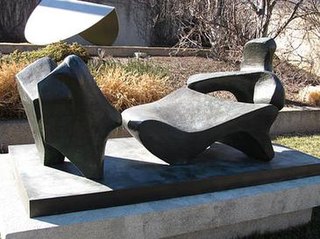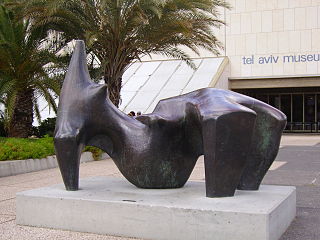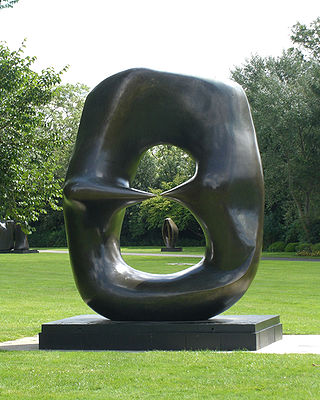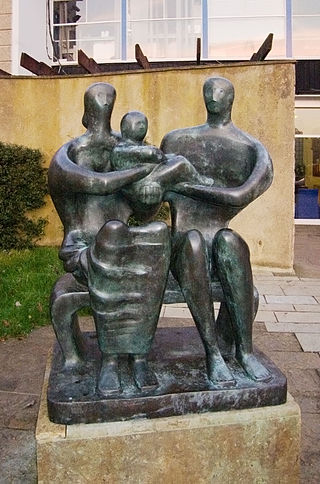
Henry Spencer Moore was an English artist. He is best known for his semi-abstract monumental bronze sculptures which are located around the world as public works of art. Moore also produced many drawings, including a series depicting Londoners sheltering from the Blitz during the Second World War, along with other graphic works on paper.

Man Enters the Cosmos is a cast bronze sculpture by Henry Moore located on the Lake Michigan lakefront outside the Adler Planetarium in the Museum Campus area of downtown Chicago, Illinois.
Glenkiln Sculpture Park was a sculpture landscape in the historic county of Kirkcudbrightshire in Dumfries and Galloway, south-west Scotland.

Three-Piece Reclining Figure No. 2: Bridge Prop is a sculpture by Henry Moore, created in 1963, and produced in an edition of six copies.

Two-Piece Reclining Figure: Points is a sculpture by Henry Moore, catalogued as LH 606, and created in 1969–70.
Draped Reclining Figure, 1952–53 is a bronze sculpture by Henry Moore, catalogued as "LH 336".
Pere Jacques Marquette is a public art work by American artist Tom Queoff, located in downtown Milwaukee, Wisconsin. The bronze figure depicts the Jesuit missionary standing with cross in hand. It is located in Pere Marquette Park near the Milwaukee County Historical Society and Riverwalk.
Lynden Sculpture Garden is a 40-acre outdoor sculpture park located at 2145 West Brown Deer Road in Milwaukee, Wisconsin in Milwaukee County. Formerly the estate of Harry Lynde Bradley and Margaret Blakney Bradley, Lynden is home to the collection of more than 50 monumental sculptures collected by Margaret Bradley between 1962 and 1978. The collection features works by Alexander Archipenko, Henry Moore, Barbara Hepworth, Clement Meadmore, Marta Pan, Tony Smith, Mark di Suvero and others sited across 40 acres of park, lake and woodland.

Sea Form (Atlantic) (BH 362) is a 1964 bronze sculpture by English artist Barbara Hepworth. It measures 204 cm × 107 cm × 73 cm (80 in × 42 in × 29 in).

Reclining Figure 1969–70 is a bronze sculpture by English artist Henry Moore.

Draped Reclining Woman 1957–58 is a bronze sculpture by British artist Henry Moore, with a series of six castings made by Hermann Noack in Berlin.

Large Four Piece Reclining Figure 1972–73 is a bronze sculpture by Henry Moore. Approximately 4 metres (13 ft) long, the sculpture was made an edition of seven full size casts, all cast by the Hermann Noack foundry in Berlin.

Reclining Figure: Festival is a bronze sculpture by English artist Henry Moore, commissioned by the Arts Council in 1949 for the Festival of Britain in 1951. The sculpture can be viewed as an abstraction of a reclining female human figure, resting on two arms, with a small head.

Three Piece Reclining Figure: Draped 1975 is a bronze sculpture by Henry Moore, catalogued as LH 655. It is approximately 4.7m long. Seven casts and an artist's proof were made. Three publicly exhibited casts are situated in the Sodra Kungsgatan in Gävle, Sweden, at the Massachusetts Institute of Technology in Boston, USA, and the Henry Moore Foundation in Perry Green, Hertfordshire.

Reclining Figure 1938 is a small sculpture by Henry Moore of an sinuous abstracted human figure. An enlarged version was made in 1984 for the Oversea-Chinese Banking Corporation, Singapore. The resulting Large Reclining Figure is some 9 metres (30 ft) long, making it the largest sculpture made by Moore.

Standing Figure: Knife Edge is a bronze sculpture by the English artist Henry Moore. It was cast in two full-size versions: Standing Figure: Knife Edge in 1961, and a larger Large Standing Figure: Knife Edge in 1976. The sculpture also is sometimes known as Standing Figure (Bone) or Winged Figure.

Oval with Points is a series of enigmatic abstract sculptures by British sculptor Henry Moore, made in plaster and bronze from 1968 to 1970, from a 14-centimetre (5.5 in) maquette in 1968 made in plaster and then cast in bronze, through a 110-centimetre (43 in) working model in 1968–1969 also made plaster and then cast in bronze, to a full-size 332-centimetre (131 in) bronze version cast in 1969.

Family Group is a sculpture by Henry Moore. It was his first large-scale bronze sculpture, and his first large bronze with multiple castings. Made for Barclay School in Stevenage, it evolved from drawings in the 1930s, through a series of models to bronze castings in 1950–51. It also one of the last important sculptures that Moore developed from preliminary drawings: in future, he worked mainly from found objects, maquettes and models.
UNESCO Reclining Figure 1957–58 is a sculpture by Henry Moore. It was made in a series of scales, from a small plaster maquette, through a half-size working model made in plaster and cast in bronze, to a full-size version carved in Roman travertine marble in 1957–1958. The final work was installed in 1958 at the World Heritage Centre, the headquarters of UNESCO at the Place de Fontenoy in Paris. This was Moore's last major public commission in which he created a new work for a specific site; he afterwards generally worked from an existing sketch or model.

Reclining Figure (Lincoln Center) (LH 519) is a statue by Henry Moore. The original two-part bronze statue of a human figure was commissioned for the Lincoln Center for the Performing Arts in New York City, where it has been displayed outdoors since 1965 in a pool of water to the north of the new Metropolitan Opera House. Other copies in plaster or bronze exist, and are displayed in other cities.
















